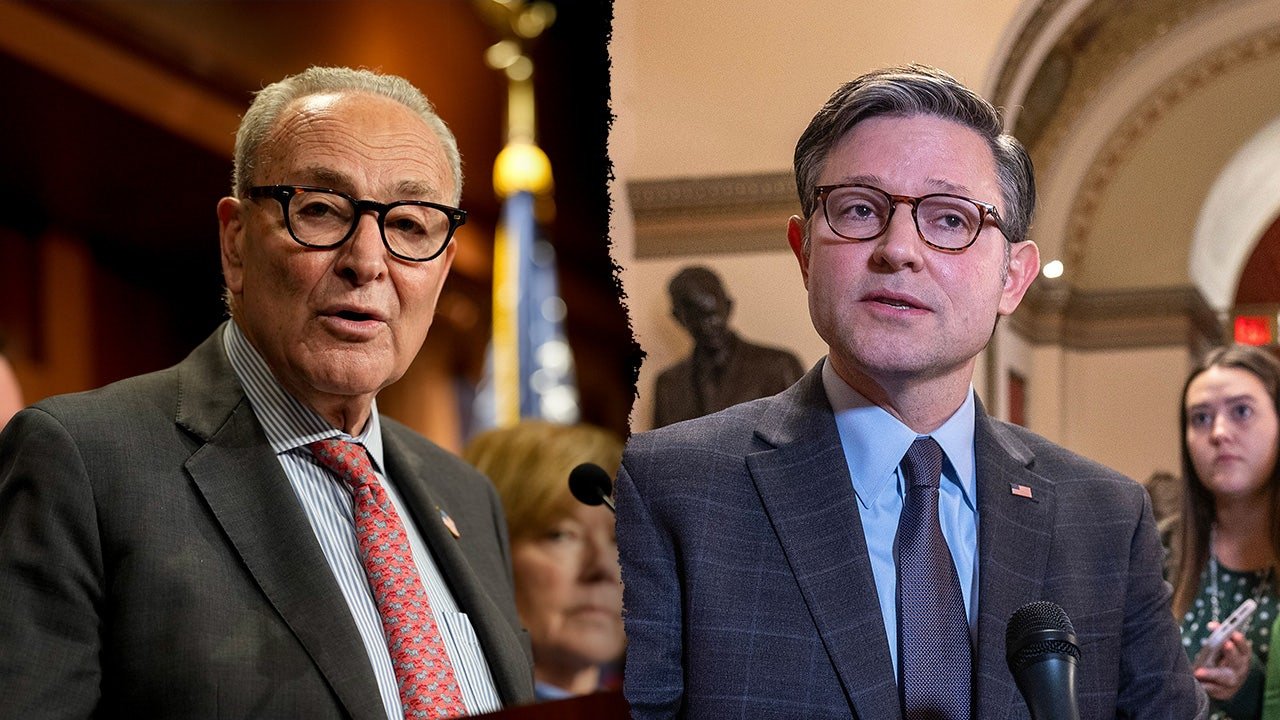INTERNACIONAL
Israel eliminates Gaza terrorist who took part in October attack on kibbutz, took Yarden Bibas hostage

NEWYou can now listen to Fox News articles!
Israel took out a terrorist during an airstrike earlier this month who was involved in the abduction of an Israeli man on Oct. 7, 2023, authorities said Tuesday.
The strike, which occurred in Gaza on Aug. 10, killed Jihad Kamal Salem Najjar, the Israel Defense Forces (IDF) and Shin Bet, Israel’s internal security agency, announced.
«A small part of my closure happened today. Thank you to the IDF, the Shin Bet, and everyone who took part in the elimination of one of the terrorists who kidnapped me on October 7,» Yarden Bibas said in a statement provided by the Hostages and Missing Families Forum. «Thanks to you, he will not be able to harm anyone else.
EX-ISRAELI OFFICIAL OFFERS BOLD 2-PRONGED STRATEGY AS ‘THE ONLY WAY’ TO FREE HOSTAGES FROM HAMAS
Israel said Jihad Kamal Salem Najjar, a terrorist believed to have been involved in the Oct. 7, 2023 attack on Israelis, was killed in airstrikes. (Israel Defense Forces)
«Please take care of yourselves, heroes. I am waiting for full closure with the return of my friends David and Ariel, and the remaining 48 hostages,» he added.
Najjar was involved in the invasion of the Kibbutz Nir Oz, one of the hardest hit during the deadly Oct. 7 attacks, where Bibas was kidnapped. Bibas’ family was kidnapped separately and was eventually murdered while in captivity.
He spent 480 days as a hostage before he was released in January. His wife, Shiri, and their two young children, Ariel and Kfir, were killed before their bodies were returned to Israel.
While in captivity, Bibas was forced to make a hostage film in which he was seen breaking down as Hamas claimed his wife and children had been killed.
ISRAEL RECOVERS REMAINS OF THREE MORE BODIES HELD BY HAMAS: ‘NO VICTORY UNTIL LAST HOSTAGE RETURNS’

Jihad Kamal Salem Najjar is seen pictured alongside hostages. (Israeli Defense Forces)
Hamas often uses hostage videos as part of what the IDF calls «psychological terror.»
Upon his release, Bibas’ family said that «a quarter of our heart has returned to us after 15 long months. … Yarden has returned home, but the home remains incomplete.»
In the aftermath of Hamas’ attack, the Bibas family became a symbol of the terror group’s cruelty. Video footage of Shiri Bibas holding her two red-headed children in her arms went viral across the globe.

Pictures of the Bibas family and Oded Lifshitz, 84, who were kidnapped during the deadly Oct. 7, 2023 attack by Hamas and then killed, are displayed next to candles in the dining room in Kibbutz Nir Oz, after their bodies were handed over to Israel under the terms of a ceasefire between Hamas and Israel, on the day of Lifshitz’s funeral, in Kibbutz Nir Oz, Israel Feb. 25, 2025. (Reuters/Amir Cohen)
CLICK HERE TO GET THE FOX NEWS APP
In April, Israel said it had killed Mohammed Hassan Mohammed Awad, a senior commander in the Palestinian Mujahideen terrorist organization and who helped lead «several» attacks on the Nir Oz kibbutz.
israel,wars,terrorism,middle east
INTERNACIONAL
Johnson shuts down House to pressure Schumer as government standstill nears one month

Sen. Lankford proposes bill to avoid government shutdowns
Fox News senior congressional correspondent Chad Pergram and Sen. James Lankford, R-Okla., join ‘The Faulkner Focus’ to discuss the failed vote to pay federal workers amid the government shutdown as they enter their first week without pay.
NEWYou can now listen to Fox News articles!
Speaker Mike Johnson, R-La., has canceled votes in the House of Representatives for a fourth straight week as the government shutdown shows no signs of ending.
Johnson’s move is a part of his continued pressure strategy on Senate Democrats and Minority Leader Chuck Schumer, D-N.Y., who have sunk the GOP’s federal funding plan 12 times since Sept. 19, when the House passed the measure.
Sept. 19 was also the last day the House was in session, meaning lawmakers have been largely in their home districts for over a month.
Republicans are pushing a short-term extension of fiscal year (FY) 2025 spending levels through Nov. 21 — called a continuing resolution (CR) — aimed at giving congressional negotiators time to strike a longer-term deal for FY2026.
SCREAMING MATCH ERUPTS BETWEEN HAKEEM JEFFRIES, MIKE LAWLER AS GOVERNMENT SHUTDOWN CHAOS CONTINUES
House Speaker Mike Johnson, right, is canceling House votes to pressure Senate Minority Leader Chuck Schumer, left, for refusing to agree to a GOP-led plan to avert a government shutdown. (Kent Nishimura/Bloomberg via Getty Images; Tasos Katopodis/Getty Images)
Democrats, furious at being sidelined in federal funding discussions, have been withholding their support for any spending bill that does not also extend COVID-19 pandemic-era enhanced Obamacare subsidies that are due to expire at the end of this year.
Johnson’s decision was made public on Friday afternoon during a brief pro forma session in the House. Under rules dictated by the Constitution, the chamber must meet for brief periods every few days called «pro forma» sessions to ensure continuity, even if there are no formal legislative matters at hand.
Pro forma sessions can also be opportunities for lawmakers to give brief speeches or introduce legislation that they otherwise would not have.
Democrats have criticized Johnson’s decision, with House Minority Leader Hakeem Jeffries, D-N.Y., telling reporters that House Republicans have been «on vacation for the last four weeks.»

The government is in a shutdown after Congress failed to reach an agreement on federal funding. (Getty Images)
Republicans, however, have largely stayed united behind Johnson as the shutdown continues.
«I mean, if all of a sudden the Senate wants to pass a clean CR, I would imagine there are some options on the table that we can pursue to get things back on track,» said Rep. Adrian Smith, R-Neb., who presided over the House chamber on Friday.
«I would defer, ultimately, to [leadership’s] decisions for the schedule. But right now, I don’t see any sign that we need to change what has been on the counter.»
But there have been several notable defections. Both Reps. Kevin Kiley, R-Calif., and Marjorie Taylor Greene, R-Ga., have made their criticism of Johnson’s strategy known publicly for weeks.
«I believe very strongly that it’s the wrong decision,» Kiley told MSNBC earlier this week, adding House lawmakers were not «doing all the things we’re supposed to be doing» aside from figuring out how to end the shutdown.
BATTLEGROUND REPUBLICANS HOLD THE LINE AS JOHNSON PRESSURES DEMS ON SHUTDOWN

Rep. Kevin Kiley, seen in August 2023, has been critical of Johnson’s shutdown strategy. (Scott Strazzante-Pool/Getty Images)
CLICK HERE TO GET THE FOX NEWS APP
Multiple House lawmakers have also raised concerns about being out of session on private weekly calls that Johnson holds with members of the GOP conference.
Rep. Beth Van Duyne, R-Texas, was the most recent House Republican to suggest the GOP could be in a stronger position if they were back in Washington, Fox News Digital was told.
«I think the longer that we are out, the messaging is starting to get old,» Van Duyne told fellow House Republicans on their Tuesday call.
house of representatives politics,mike johnson,politics,chuck schumer
INTERNACIONAL
US deploys Ford carrier strike group to combat narco-terror in Western Hemisphere

NEWYou can now listen to Fox News articles!
The Trump administration has ordered the deployment of the Gerald R. Ford Carrier Strike Group in the Western Hemisphere as the U.S. continues to target suspected drug smuggling vessels in the Caribbean.
«In support of the President’s directive to dismantle Transnational Criminal Organizations (TCOs) and counter narco-terrorism in defense of the Homeland, the Secretary of War has directed the Gerald R. Ford Carrier Strike Group and embarked carrier air wing to the U.S. Southern Command (USSOUTHCOM) area of responsibility (AOR),» chief Pentagon Spokesman Sean Parnell said in a statement Friday.
«The enhanced U.S. force presence in the USSOUTHCOM AOR will bolster U.S. capacity to detect, monitor, and disrupt illicit actors and activities that compromise the safety and prosperity of the United States homeland and our security in the Western Hemisphere,» he added. «These forces will enhance and augment existing capabilities to disrupt narcotics trafficking and degrade and dismantle TCOs.»
The Trump administration has ordered a number of strikes in the Caribbean aimed at dismatling and disrupting drug cartels in the region.
Most recently, War Secretary Pete Hegseth announced on Thursday that a strike on a vessel allegedly operated by members of Tren de Aragua (TdA), a Designated Terrorist Organization (DTO), killed six alleged narco-terrorists.
This story is breaking. Please check back for updates.
military
INTERNACIONAL
La neurociencia revela cómo se forman y modifican los hábitos

La neurociencia ha demostrado que los hábitos, esos comportamientos automáticos que moldean la rutina diaria y repercuten en la salud mental, surgen de la interacción entre dos sistemas cerebrales: uno responsable de responder a estímulos y otro orientado por metas y creencias.
Esta perspectiva, presentada mediante un estudio publicado en enero de 2025 por investigadores del Trinity College Dublin, está transformando la comprensión sobre la formación y modificación de los hábitos, con efectos directos en la vida cotidiana y en el tratamiento de trastornos compulsivos.
Eike Buabang y su equipo destacan el denominado marco de doble sistema. Este concepto, respaldado por la neurociencia cognitiva, sostiene que los hábitos resultan del equilibrio entre un sistema de control dirigido por objetivos —basado en la evaluación consciente de acciones y resultados— y un sistema estímulo-respuesta, que automatiza conductas frente a señales familiares.
Cuando el sistema estímulo-respuesta domina, las personas tienden a repetir acciones sin analizar su relación con metas actuales, lo que puede derivar en errores, impulsividad o conductas compulsivas. Como señalan Buabang y sus colegas: “Los hábitos pueden entenderse como un balance entre un sistema impulsado por estímulos, basado en asociaciones estímulo-respuesta, y un sistema dirigido por objetivos, basado en expectativas acción-resultado y metas valoradas”.

La formación de hábitos responde a varios mecanismos clave. Destaca la repetición, ya que cada vez que una conducta se repite en un contexto similar, las conexiones neuronales entre estímulo y respuesta se refuerzan, facilitando su automatización. No obstante, el estudio muestra que la evidencia es dispar sobre cuántas repeticiones se requieren: algunos trabajos sitúan el rango entre 18 y 254 días, según el tipo de hábito y características de la persona.
El refuerzo —la obtención de consecuencias positivas tras la acción— fortalece los hábitos, gracias en parte a la dopamina en regiones cerebrales como el putamen posterior. Además, cuando se desactivan los procesos dirigidos por objetivos, por presión de tiempo, estrés o distracción, el sistema estímulo-respuesta asume el control. La estabilidad del contexto favorece la consolidación de los hábitos, ya que la repetición en entornos previsibles disminuye la necesidad de supervisión consciente y permite que las acciones se encadenen de modo automático.
Existen diferencias individuales y neurobiológicas que influyen en la facilidad para formar o interrumpir hábitos. La estructura y actividad de circuitos como el putamen y la corteza prefrontal dorsolateral varían entre personas, lo que explica por qué algunos adquieren hábitos con rapidez mientras que otros precisan más tiempo o repeticiones. Además, la intensidad de las señales contextuales, la frecuencia de repetición y la motivación —tanto intrínseca como extrínseca— modulan este proceso. Según la investigación: “La duración necesaria para formar un hábito varía considerablemente entre individuos”, lo que resalta la importancia de personalizar las estrategias de intervención.
Romper hábitos arraigados requiere debilitar las asociaciones estímulo-respuesta, evitar los estímulos desencadenantes, potenciar la inhibición dirigida por objetivos y, en muchos casos, crear hábitos alternativos que compitan con los anteriores. La extinción de un hábito no elimina las conexiones previas, sino que genera una nueva asociación entre el contexto y la ausencia de respuesta, lo que explica la propensión a recaer frente a los estímulos originales.
Estrategias como la evitación de contextos problemáticos, el entrenamiento en inhibición y la formación de intenciones de implementación (“si ocurre X, haré Y”) presentan eficacia tanto en entornos experimentales como en la vida cotidiana. Estas técnicas operan en terapias conductuales y farmacológicas, y pueden potenciarse mediante intervenciones como la estimulación cerebral no invasiva, que refuerza el control ejecutivo.

Las aplicaciones clínicas de estos avances resultan especialmente relevantes en trastornos compulsivos, como el trastorno obsesivo-compulsivo (TOC), las adicciones y los trastornos alimentarios. En estos casos, se identifica un déficit en el control dirigido por objetivos, lo que favorece la aparición de hábitos patológicos. Como advierte la investigación: “El trastorno obsesivo-compulsivo, el trastorno por consumo de sustancias y los trastornos alimentarios están vinculados a déficits en el control dirigido por objetivos, posiblemente explicados por una dimensión transdiagnóstica de compulsividad”.
Las terapias más eficaces combinan la exposición a los estímulos desencadenantes, la prevención de la respuesta habitual y el refuerzo de conductas alternativas, lo que permite abordar tanto mecanismos automáticos como procesos conscientes.
A pesar de estos avances, la investigación actual enfrenta desafíos metodológicos y conceptuales. Persisten dificultades para replicar hallazgos clave en humanos y continúa el debate sobre la suficiencia del modelo de doble sistema. Buabang y sus colegas proponen modelos más complejos, integrando la interacción dinámica entre hábitos de pensamiento, creencias automáticas y conductas. La transferencia de hábitos entre contextos y la resistencia al cambio figuran como áreas de estudio aún en desarrollo.
Hacia el futuro, la investigación subraya la importancia de profundizar en los mecanismos subyacentes a la formación y alteración de hábitos, así como adaptar las intervenciones a las distintas características individuales y contextuales. Solo mediante una comprensión más precisa de estos procesos será posible diseñar estrategias realmente eficaces para promover cambios conductuales duraderos y mejorar el abordaje de trastornos relacionados con la compulsividad.
deporte,running,mujeres,parque,ejercicio,vida saludable,mañana,ciudad,bienestar,actividad física

 CHIMENTOS2 días ago
CHIMENTOS2 días agoAdabel Guerrero confesó de qué famosa está enamorada y que le encantaría tener relaciones: «La China Suárez me sorprendió con su belleza»

 DEPORTE2 días ago
DEPORTE2 días agoUniversidad de Chile vs. Lanús, por la Copa Sudamericana: día, horario y cómo verlo por TV

 POLITICA2 días ago
POLITICA2 días agoDiego Luciani, sobre la condena a Cristina Kirchner: “No hay sentencia ejemplar sin recuperar lo robado”

























